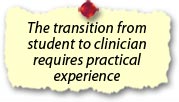|
|
|
Jarrod Shapiro, DPM
Practice Perfect Editor
Assistant Professor,
Dept. of Podiatric Medicine,
Surgery & Biomechanics
College of Podiatric Medicine
Western University of
Health Sciences,
St. Pomona, CA |
As I sit here writing this, it is exactly 3:01 AM on a Saturday morning. It's quiet in the Shapiro household. My wife and kids are sleeping. I'm sitting in my living room with my laptop computer. It's dark outside – 3 hours before the sun will rise to start another day. For me, this is an all too common situation – waking up at night. I generally lay in bed for some unknown time, having been awoken from sleep by something: the baby crying, the need to go to the bathroom, whatever. After failing to return to sleep, I get out of bed and come downstairs to keep my wakefulness from metastasizing to my wife.
 Although insomnia is thought to occur in about one-third of the general population,1 forced lack of sleep, in the form of overnight work, is a common part of many physicians' lives. Now, I'm happy to say that my 2 AM overnight calls have become somewhat minimal over the years. One of the pluses about podiatric medicine as a career is the lack of immediate emergent care, minus abscess, acute trauma, or a couple of other problems. Most of the time when I'm awake at night, it is due to my own insomnia rather than the need to rush out to the hospital. Although insomnia is thought to occur in about one-third of the general population,1 forced lack of sleep, in the form of overnight work, is a common part of many physicians' lives. Now, I'm happy to say that my 2 AM overnight calls have become somewhat minimal over the years. One of the pluses about podiatric medicine as a career is the lack of immediate emergent care, minus abscess, acute trauma, or a couple of other problems. Most of the time when I'm awake at night, it is due to my own insomnia rather than the need to rush out to the hospital.
However, for many of our colleagues, especially those in training, long overnight shifts are highly common. Anyone who hasn't lived under a rock for the past 10-15 years is quite aware of the national safety question in hospitals as a result of possible sleeplessness-induced errors by our medical trainees. This national epidemic led to some high profile changes. In 2003, the ACGME (Accreditation Council on Graduate Medical Education) established rules on resident duty hour restrictions including:2
- An 80-hour weekly limit, averaged over four weeks, inclusive of all in-house call activities.
- A 10-hour rest period between duty periods and after in-house call.
- A 24-hour limit on continuous duty, with up to 6 additional hours for continuity of care and education.
- No new patients to be accepted after 24 hours of continuous duty.
- One day in seven free from patient care and educational obligations, averaged over four weeks, inclusive of call.
- In-house call no more than once every three nights, averaged over four weeks.
Interestingly, these rules are only in effect for PGY 1 residents. The ACGME makes other recommendations for more advanced trainees, but have not mandated these changes. For example, they recommend strategic napping between the hours of 10 PM and 8 AM for shifts over 30 hours.
Do these regulations improve care for our patients?
A study in the Annals of Internal Medicine in 2007 looked at this question, and found that in 551 hospitals surveyed, the current regulations resulted in a 3.375% relative risk reduction for death and a 0.25% overall decrease in absolute mortality.3 The effect was found only for medical patients, with no change in surgical patients.
Similarly, a study published in JAMA in 2007 that looked at the first 2 years post-reform also found an improvement in VA hospitals.4 The authors compared mortality rates of patients admitted with certain medical and surgical diagnoses (for example, acute MI) to hospitals of varying teaching intensity (based on resident to bed ratio).The authors found an 11.1% to 13.9% relative decrease in mortality from the medical conditions, depending on teaching intensity (higher intensity hospitals had greater mortality reductions). Interestingly, these authors also found no change in mortality with the surgical patients. Due to these being observational studies, it is impossible to know if the mortality improvement was directly related to the new regulations. However, the authors found the results to be encouraging.
Clouding this issue, though, the same authors performed a sister study of 8,000,000 Medicare beneficiaries in non-federal hospitals during the same 2007 time frame, looking at the pre- versus 2 year post-reform time periods. The researchers found no difference in mortality (either improved or worsened) after the ACGME duty hour reforms.5 The authors explained the divergent findings between VA hospitals in the first study and non-federal hospitals in the second study as due to the significantly higher teaching intensity and greater resident autonomy at VA hospitals. If true, there may be a threshold in which a greater teaching intensity correlates with improved patient care as a result of these resident duty hour reforms.
Unfortunately, the best research available does not tell us if these reforms are actually beneficial for patients.
From an educational standpoint, many residents dislike the restrictions, arguing they need the extra time to complete their learning process and maintain continuity of patient care. I remember one night when I was a resident, sitting in the hospital with my residency director. We were lamenting our relative lack of sleep, when my director made an interesting comment that has stayed with me through my seven years of practice. He said, "Residency education often takes place outside of standard hours."
 To this day, I find his statement to be a profound commentary on modern medical education. Much of medicine may be learned via books, but the transition from student to clinician requires practical experience. The logical conclusion to this line of reasoning is the more time spent training, the more likely the trainee is to have experiences, and the better the overall education. What this means for resident education as it relates to duty hours and patient safety is anyone's guess. Keep that in mind the next time your resident calls you in the middle of the night. Sleep tight. To this day, I find his statement to be a profound commentary on modern medical education. Much of medicine may be learned via books, but the transition from student to clinician requires practical experience. The logical conclusion to this line of reasoning is the more time spent training, the more likely the trainee is to have experiences, and the better the overall education. What this means for resident education as it relates to duty hours and patient safety is anyone's guess. Keep that in mind the next time your resident calls you in the middle of the night. Sleep tight.
Best wishes.

Jarrod Shapiro, DPM
PRESENT Practice Perfect Editor
[email protected]
References:
- Ohayhon M. Sleep Medicine Review, April 2002; 6(2): 97-111.
- ACGME standards. Accessed on 5/17/2013.
- Shetty K and Bhattacharya J. Annals of Internal Medicine, July 2007;147(2): 73-80.
- Volpp K, et al. Journal of the American Medical Association, Sept 2007; 298(9): 984-992.
- Volpp K, et al. Journal of the American Medical Association, Sept 2007; 298(9): 975-983.
Get a steady stream of all the NEW PRESENT Podiatry
eLearning by becoming our Face book Fan.
Effective eL earning and a Colleague Network await you. |
 |
This ezine was made possible through the support of our sponsors: |
|